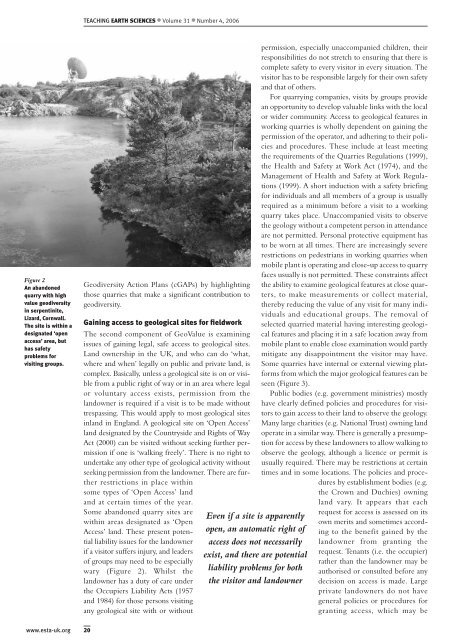teaching - Earth Science Teachers' Association
teaching - Earth Science Teachers' Association
teaching - Earth Science Teachers' Association
You also want an ePaper? Increase the reach of your titles
YUMPU automatically turns print PDFs into web optimized ePapers that Google loves.
TEACHING EARTH SCIENCES ● Volume 31 ● Number 4, 2006<br />
Figure 2<br />
An abandoned<br />
quarry with high<br />
value geodiversity<br />
in serpentinite,<br />
Lizard, Cornwall.<br />
The site is within a<br />
designated ‘open<br />
access’ area, but<br />
has safety<br />
problems for<br />
visiting groups.<br />
Geodiversity Action Plans (cGAPs) by highlighting<br />
those quarries that make a significant contribution to<br />
geodiversity.<br />
Gaining access to geological sites for fieldwork<br />
The second component of GeoValue is examining<br />
issues of gaining legal, safe access to geological sites.<br />
Land ownership in the UK, and who can do ‘what,<br />
where and when’ legally on public and private land, is<br />
complex. Basically, unless a geological site is on or visible<br />
from a public right of way or in an area where legal<br />
or voluntary access exists, permission from the<br />
landowner is required if a visit is to be made without<br />
trespassing. This would apply to most geological sites<br />
inland in England. A geological site on ‘Open Access’<br />
land designated by the Countryside and Rights of Way<br />
Act (2000) can be visited without seeking further permission<br />
if one is ‘walking freely’. There is no right to<br />
undertake any other type of geological activity without<br />
seeking permission from the landowner. There are further<br />
restrictions in place within<br />
some types of ‘Open Access’ land<br />
and at certain times of the year.<br />
Some abandoned quarry sites are<br />
within areas designated as ‘Open<br />
Access’ land. These present potential<br />
liability issues for the landowner<br />
if a visitor suffers injury, and leaders<br />
of groups may need to be especially<br />
wary (Figure 2). Whilst the<br />
landowner has a duty of care under<br />
the Occupiers Liability Acts (1957<br />
and 1984) for those persons visiting<br />
any geological site with or without<br />
Even if a site is apparently<br />
open, an automatic right of<br />
access does not necessarily<br />
exist, and there are potential<br />
liability problems for both<br />
the visitor and landowner<br />
permission, especially unaccompanied children, their<br />
responsibilities do not stretch to ensuring that there is<br />
complete safety to every visitor in every situation. The<br />
visitor has to be responsible largely for their own safety<br />
and that of others.<br />
For quarrying companies, visits by groups provide<br />
an opportunity to develop valuable links with the local<br />
or wider community. Access to geological features in<br />
working quarries is wholly dependent on gaining the<br />
permission of the operator, and adhering to their policies<br />
and procedures. These include at least meeting<br />
the requirements of the Quarries Regulations (1999),<br />
the Health and Safety at Work Act (1974), and the<br />
Management of Health and Safety at Work Regulations<br />
(1999). A short induction with a safety briefing<br />
for individuals and all members of a group is usually<br />
required as a minimum before a visit to a working<br />
quarry takes place. Unaccompanied visits to observe<br />
the geology without a competent person in attendance<br />
are not permitted. Personal protective equipment has<br />
to be worn at all times. There are increasingly severe<br />
restrictions on pedestrians in working quarries when<br />
mobile plant is operating and close-up access to quarry<br />
faces usually is not permitted. These constraints affect<br />
the ability to examine geological features at close quarters,<br />
to make measurements or collect material,<br />
thereby reducing the value of any visit for many individuals<br />
and educational groups. The removal of<br />
selected quarried material having interesting geological<br />
features and placing it in a safe location away from<br />
mobile plant to enable close examination would partly<br />
mitigate any disappointment the visitor may have.<br />
Some quarries have internal or external viewing platforms<br />
from which the major geological features can be<br />
seen (Figure 3).<br />
Public bodies (e.g. government ministries) mostly<br />
have clearly defined policies and procedures for visitors<br />
to gain access to their land to observe the geology.<br />
Many large charities (e.g. National Trust) owning land<br />
operate in a similar way. There is generally a presumption<br />
for access by these landowners to allow walking to<br />
observe the geology, although a licence or permit is<br />
usually required. There may be restrictions at certain<br />
times and in some locations. The policies and procedures<br />
by establishment bodies (e.g.<br />
the Crown and Duchies) owning<br />
land vary. It appears that each<br />
request for access is assessed on its<br />
own merits and sometimes according<br />
to the benefit gained by the<br />
landowner from granting the<br />
request. Tenants (i.e. the occupier)<br />
rather than the landowner may be<br />
authorised or consulted before any<br />
decision on access is made. Large<br />
private landowners do not have<br />
general policies or procedures for<br />
granting access, which may be<br />
www.esta-uk.org<br />
20

















